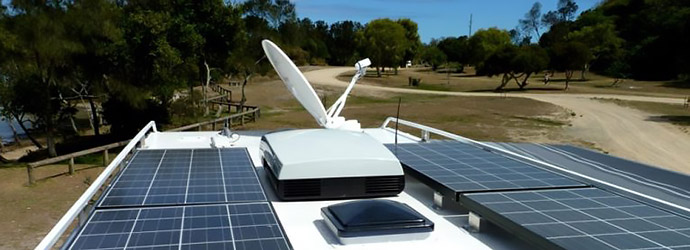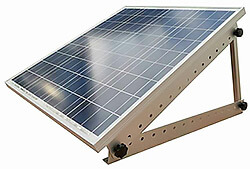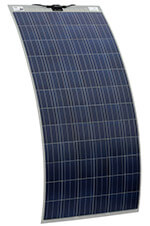Solar panels for caravans or campers: tips, types, fitting kits

If you want to be self-sufficient in terms of your electricity needs, then solar panels could very well be the answer to your caravan or camper energy quandaries. Getting photovoltaic solar panels that turn sunlight into electricity is a great way to recharge your onboard batteries. Once installed, solar panels provide clean energy silently from pretty much anywhere.
Before getting all kitted out with panels, batteries and parts, you have to think about what kind of solar panel is best suited for your caravan since there are quite a few to choose from.
Some solar configurations are more efficient than others and each caravan or camper will have its own solution. Let’s take a look at what is on offer and how to choose from all the different sustainable mobile electricity options on the camper and caravan markets.
Caravan solar panel types
There are several kinds of solar panels available on the market today. You can choose between rigid or flexible models as well as between monocrystalline and polycrystalline photovoltaic panel technologies. Below you will find out about the differences, pros, cons and what works best for your caravan or campervan.
Rigid solar panels
Rigid solar panels are based on photovoltaic solar cells laid out under tempered glass. They can vary greatly in size from large installations for residential homes to small charging panels for juicing up small electronic devices, anywhere between 20 to 30W.

Most panels are framed with aluminium to maintain their rigidity and enhance their weatherproof design. These types of solar panel can withstand hail, sand and wind. The glass is scratch proof to a certain extent because solar panel efficiency can be greatly reduced by damage to the protective glass layer. Tempered glass is a great choice for the protective layer because it facilitates cleaning in all conditions (even with ice scrapers).
Generally speaking, the price per watt for rigid panels tends to be the most competitive in the transportable panel class. At the same, their sturdy build helps with setting up and angling them for optimum sunlight.
Pros for rigid panels
- Solid build quality
- Cheaper than flexible panels
- Easier to place in sunlight
- The aluminium frame facilitates ventilation
- Best-in-class efficiency
Cons for rigid panels
- Relatively heavy
- They can affect aerodynamics and not fit neatly on roofs
- They require a mounting frame for set up
- They require drilled mounting points for permanent installation
Rigid solar panels are a strong choice for caravans and campers due to their excellent durability and increased efficiency.
The best rigid solar panels for caravans and campervans
Caravan and campervan owners are spoilt for choice when it comes to rigid solar panel brands and models. Due to their simple and fairly standard construction, there isn’t a huge difference between quality and materials from one panel to the next.

There are a few market leaders with a range of panels and sizing options. Renogy, ECO-Worthy and Enjoy are three brands worth checking out with all their products having comparable levels of power efficiency, weather resistance and warranty duration.
Most solar panels made by these brands are designed for mobile outdoor use for caravans, campsites and boats. They have a light but sturdy construction with mounting points for standard brackets and kits.
These panels are built around an aluminium base and frame which will let you use them as portable or roof-mounted solar panels based on your needs. One of the benefits of the aluminium-based structure is that it elevates solar cells which results in better ventilation. The air gap between the solar cells and the roof keeps things cool which, in turn, results in improved efficiency and durability.
Every solar panel part, from the junction box to the MC4 connectors, are waterproof. This means that you can travel in all weather conditions without the risk of damage to your solar panel installation.
Flexible solar panels
Flexible solar panels are made out of moulded solar cells with a protective plastic layer on top. Since they aren’t framed, unlike rigid solar panels, this means that they have a low profile and can be bent to conform with the gentle curves of caravan or campervan roofs.

These panels are even lighter than rigid solar panels making them usable on a wider range of installations. However, flexible solar panels are much more prone to scratches and other kinds of damage because of that thinner plastic protective layer used in their manufacture. However, due to their flexible design, it is much less likely that the panel would crack due to a significant impact.
When they were first launched, flexible solar PV panels would often have connection and short circuit issues between solar cells when they were bent too far. However, as manufacturing practices have improved, these kinds of issues have been mitigated. Nevertheless, flexible solar panels have shorter warranties than those offered for rigid solar panels.
Flexible panels are generally more limited in terms of solar exposure because they are not independent. Their position is determined by the surface to which they are mounted along.
Pros for flexible panels
- Lower profile
- They can bend up to 30º
- Light construction
- Easy to install
Cons for flexible panels
- More susceptible to scratches
- Less durable
- More expensive in terms of price per watt generated
Solar panels operate optimally when their whole surface area is evenly exposed to sunlight. With flexible solar panels, the more their surfaces are flexed, the less efficient they are because there will be a certain area getting less direct light than the rest.
Flexible solar panels are the best option if:
- You care about aesthetics and don’t want solar panels jutting out.
- Whenever the only available mounting surface is significantly curved.
- If you want to avoid drilling or needing a sturdy mounting kit.
Best flexible solar panels for campers and caravans
Like with fixed solar panels, you are also spoilt for choice when it comes to flexible panels. Most flexible solar panel manufacturers offer share similar warranties, efficiency and durability ratings.
Renogy and Allpowers are the leading brands in the flexible solar panel market. Allpowers uses Sunpowers solar cells in their products which makes them some of the most energy-efficient on the market.
Compact solar panels and solar chargers
Portable solar panels and solar chargers usually look like briefcases that unfold to reveal a solar panel. They are easy to put up to meet temporary needs for electrical power. They are ideal for charging electronic devices such as phones, tablets or laptops while travelling.
Pros for compact solar chargers
- Very easy to set up
- They don’t need to be mounted anywhere
- They can easily be moved to get better sunlight exposure
- You can leave them set up in the sun while your camper or caravan is in the shade
Cons for compact solar chargers
- Easily scratched or damaged
- Short operating life
- Most expensive price per watt
Solar Generators
These are self-contained products most suited to people who don’t want to have to deal with extensive cabling and a complex system. Solar generators take the form of boxes that are ready to go and already set up as an all-in-one system which essentially makes them plug and play.
They are great for people who don’t know a lot about solar power or how to make electricity using renewables. While solar generators are more expensive when compared to a more DIY solution, they make it up in terms of simplicity and speed of set up.
Solar cell technology: monocrystalline vs. polycrystalline
Photovoltaic or PV solar panels are made up of smaller cells manufactured from crystalline silicon. Depending on the manufacturing process, solar panels will be based on either monocrystalline or polycrystalline silicon.
While there is a lot of discussion on the merits and efficiency of monocrystalline and polycrystalline, the fact is that a 100W panel will output the same level of electricity no matter which technology your solar panel uses.
It is worth bearing in mind that:
- Monocrystalline-based solar panels are more efficient overall. They take up less space but they are also more expensive.
- Polycrystalline-based solar panels are cheaper but they must be larger to match the power output of monocrystalline designs.
Both technologies have the same durability and lifespan expectations, meaning that the advantage of one over the other comes down to size only. Essentially, you can’t go wrong with either one, as long as you have done your homework regarding panel size and your energy needs.
How many solar panels will your caravan or campervan need?
To find out how many solar panels you are going to need as well as the solar panel size that is best for your caravan or camper van, you need to know what your electricity use is. Doing so will guarantee that you can meet your energy needs and ensure your solar panels are cost-effective.
Before moving on, you do need to take the following characteristics that are shared by most solar panels:
- There will be an 8% loss of efficiency when the panels are in operation.
- The location of your solar panels needs to be optimal in order to capture as much energy as possible. This means they need to be angled at around 45º.
- Peak sun hours account for variances in solar radiation based on seasonal changes according to your location.
Once you’re clear on the above three elements, you can estimate how much electricity your camper or caravan draws. To do so, you can create an energy usage table like the one below, containing the power ratings of the devices or appliances that will be dependent on the solar panels, as well as how long they will be operating for:
| Appliance | Power in W | # of appliances | Daily hours of use | Wh per day |
|---|---|---|---|---|
| 12v fridge | 50 | 1 | 8 | 400 |
| Portable heater | 35 | 1 | 4 | 140 |
| Water pump | 50 | 1 | 0.5 | 25 |
| LED lighting | 5 | 4 | 4 | 80 |
| Mobile charger | 5 | 2 | 4 | 40 |
| Total | 685 |
You could also add laptops, TVs and a power inverter (if you need a 220V supply) and whatever else is part of your daily power consumption. If we continue with the above example, you will need 685Wh a day.
The next step is to account for the unavoidable loss of energy through cables, controllers and battery load - a system efficiency rating of 75% is realistic.
Total energy needed: Wh/0.75 = 913 Wh per day
Now knowing this value, we can look at how many solar panels would be necessary to meet demand. Since solar panels that are rated for 100W have proven to be the most popular on the market, we are going to base our estimations based on these values.
The next step is to figure out what the Peak Sun Hours (PSH) are for our relevant area. In the example below, you can see the yearly solar radiation stats for Wiltshire.
| Month | Solar radiation value |
|---|---|
| Jan | 1.18 |
| Feb | 2.00 |
| Mar | 3.69 |
| Apr | 5.5 |
| May | 5.68 |
| Jun | 5.75 |
| Jul | 5.84 |
| Aug | 5.19 |
| Sep | 4.4 |
| Oct | 2.72 |
| Nov | 1.4 |
| Dec | 2 |
| Yearly average | 3.7 |
source: Royal Meteorological Society
From the above table, your best bet is to take the lowest monthly solar radiation average (0.99 for December), in our example, we are continuing with Wiltshire.
If during your travels you move between significantly different latitudes, it is worth checking out the lowest value for each area you will spend time in and then base your calculations on the least favourable values.
This is all the data we need to find out the number of solar panels that will be sufficient for your caravan or camper van. There are two possible ways of doing the calculations. The first method is more suited for occasional use (such as weekend getaways or 1 to 2 week holidays).
Number of solar panels needed= (3 x daily electricity use) / (PSH x system efficiency x 7 x solar panel rating in watts)
If we plug in our example solar data for Wiltshire, let’s see what we get:
Number of solar panels needed= (3 x 913) / (2 x 0.75 x 7 x100) = 2.6 or to be safe 3 solar panels
However, if you are planning on using your solar panels for extended periods of time, the formula you use will vary slightly:
Number of solar panels needed= (daily electricity use) / (PSH x system efficiency x solar panel rating in watts)
If we plug in the same Wiltshire solar data again, this is what we get:
Number of solar panels needed= (913) / (2 x 0.75 x 100) = 6 panels
The numbers in this example are rounded to demonstrate what is needed to ensure energy independence.
Fitting solar panels to caravans and campers
If you decided to go for a permanent solar panel installation, you will need a mounting kit to set things up on your camper or caravan.
Mounting kits will let you lower the solar panels when you’re on the road and then angle them according to the peak solar angle and hour figures based on your location. Be aware that solar panels work best when they are sufficiently cooled. Mounting kits allow for free-flowing ventilation which can only help with the process.
Another thing to bear in mind is that because flexible solar panels are glued to the roof, it means that they cannot benefit from ventilation or angling to keep their performance optimal.
Pros for fixed panel mounting kits
- They will generate electricity as long as there is sunlight
- They don’t take up space inside the caravan or camper
- They can adapt easily to energy needs
- They can double up as a curtain or shade to provide cover
Cons for fixed panel mounting kits
- The installation will be more complex
- Increases the height of the caravan or camper van
- Limits what you can do with roof in terms of additional storage
- You will have to position your vehicle in full sunlight to get electricity (meaning it will be hotter inside during the summer)
Solar panel cabling and connection options
Just like with batteries, solar panels can either be set up in parallel or in series. What does this mean in terms of setting up solar panels?
Solar panels that are set up in parallel have all their positive cables going to the same connection on the controller. The negative cables do the same, all going to a common interconnector before being hooked up to the corresponding negative terminal on the controller box.
Cable thickness will largely depend on the length of cable required as well as the voltage and amperage dictated by your electricity needs.
In the following table, you can check what kind of cable you will need to hook up a 12V solar set up.
| Power in amps | Distance away from panels in meters | ||||
| 5 | 10 | 20 | 40 | ||
| 1 | 1 | 1 | 1.5 | 2.5 | |
| 2 | 1 | 1.5 | 2.5 | 6 | |
| 4.2 | 1.5 | 2.5 | 6 | 10 | |
| 8.4 | 2.5 | 6 | 10 | 20 | |
| 16.8 | 6 | 10 | 20 | 40 | |
| 33.4 | 10 | 20 | 40 | 80 | |
How to fit caravan solar panels on a caravan?
To fully install solar panels on your caravan or camper van, you are going to need the following parts: solar panels, batteries, solar charge controller, junction box and an optional inverter in case you want to use devices or appliances that run on a 220v AC circuit.
The following video looks at what is involved when it comes to setting up solar panels.
Solar panel kits
If you are planning on installing solar panels on your caravan or camper van, especially of the rigid variety, then all in one kits are a great option to get started. A kit will include all the needed parts (panels, regulator, junction box and connections) so you can get started on generating your own sustainable electricity.
The main differences to look out for in these solar generation kits are:
- Solar panel type (monocrystalline or polycrystalline)
- Power output rating (in Watts)
- Power regulator type (PWM or MPPT)
- Batteries (whether they’re included or not)
- AC inverter (whether it’s included or not)
The most efficient kits are those that are based around a Maximum Power Point Tracking type regulator (MPPT) instead of a Pulse Width Modulation model (PWM). The main job of a solar power regulator is to protect the battery and ensure it operates optimally by controlling how much power gets sent to it. Let’s have a look at the pros and cons of both PWM and MPPT solar power controllers
PWM Solar power controllers
This is the more traditional technology out of the two and it foregoes the use of mechanical relays to operate circuits that were present in older regulators.
Pros of Pulse Width Modulation solar regulators
- Being a proven technology makes them more affordable
- Durable design only requiring passive cooling
- A wide range of sizes, amperage ranges and applications
Cons of Pulse Width Modulation solar regulators
- Smaller PWM controllers aren’t UL certified
- Solar panel nominal voltage cannot exceed the battery’s stated voltage rating
- PWM regulators cannot adapt to a growing solar installation
MPPT Solar power controllers
The killer feature of this newer technology is its ability to turn excess power coming from the solar panels into amperage which brings a significant advantage to the table. Since most caravan solar panel installations run on 12V batteries, solar panels output far higher voltages than what is required to charge up the batteries. Instead of wasting the excess voltage, MPPT controllers turn the unused voltage into amps which charges the battery quicker. At the end of the day, this means batteries that are charged quicker and stay charged for longer, a clear win-win.
Pros of Maximum Power Point Tracking solar regulators
- Increased charging efficiency by up to 30%
- Able to take on a higher input voltage than what the connected batteries can handle
- You can add batteries to grow your system without having to swap regulators
- Longer warranty periods
Cons of Maximum Power Point Tracking solar regulators
- More expensive, sometimes costing twice as much as PWM
- Larger unit dimensions than PWM
- MPPT manufacturer guide needs to be followed to get them to operate optimally
- You may need to cable your solar panel in a different way than you did previously
The main difference in solar panel type chosen for a mobile installation will be in its sizing. However, the power rating is unaffected no matter what panel type you pick out.
Solar panels and weather
Once your solar panels are up and running, the weather will be your main concern (and potentially a source of headaches) when it comes to getting enough energy in your caravan.
The jury is out when it comes to cleaning solar panels but they should be inspected with some regularity to ensure they are not severely scratched or damaged. However, a normal amount of dust will not affect solar panel efficiency in any appreciable way.
Correct angles for your solar panels
The majority of mounting kits will allow you to change the angle of your rigid solar panels to match the sun when you are parked during those Peak Sun Hours. Having the ability to angle your panels correctly can net you a 25% increase in electrical capacity, if you follow through with the correct angles.
Portable solar panels often prove to be easier to angle since they’re not attached to the body of your caravan or camper van.
Flexible solar panels won’t be able to adapt their angle to match optimal values for your location or time of year, this is because, more often than not, they will be conforming to the shape of your caravan roof.
Shade: the enemy of solar panels
Most solar panels are very sensitive to shade. Even if only part of a panel is covered by shade, you could find that electrical generation drops significantly. For example if a single solar cell on a specific row is shaded, it means the whole row becomes inactive.
Don’t expect to be able to park up in the shade and still be able to make a cuppa. To get your solar panels up to full efficiency always seek out the brightest spots.
